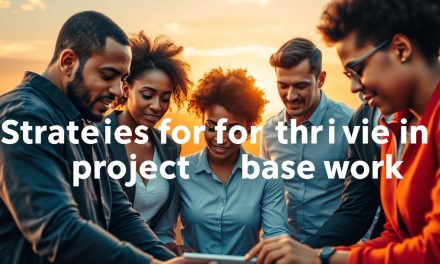Surprising fact: nearly half of Americans say they are unhappy at work, a signal that clear development paths are urgently needed.
We guide independent professionals in France to strengthen their skills and set clear career goals without sacrificing stability. Bill Eckstrom’s view — that development is the input and growth is the result — frames our approach.
Through targeted trainings, recognized credentials like PMP and CBAP, and practical on-the-job learning, you gain tools to make confident decisions about your career and business relationships.
Our advice focuses on security-first choices: how to use resources, evaluate opportunities, and align your development with a company’s culture and needs.
Expect practical steps to protect learning time, track progress, and turn environment-driven change into measurable success for you and the organizations you serve.
Table of Contents
Key Takeaways
- Development gives you a clear path to improve skills and achieve career goals.
- Top 2024 certifications can speed your progress and prove value to clients and companies.
- Structured time and the right resources protect stability while you advance.
- Align learning with company culture to make your work more impactful.
- We offer security-focused guidance so you act confidently and measure outcomes.
- See more on shaping your path at professional development and career opportunities.
Professional growth vs. professional development: what they mean for your future
Clear results come from intentional actions; understanding the difference matters for your next role. Growth shows up as measurable outcomes: promotions, client impact, or higher revenue.
Development is the disciplined input that produces those outcomes. It includes on-the-job stretch assignments, coaching, formal courses, and even personal pursuits that sharpen patience and coaching skills.
Growth is the outcome; development is the input that creates it
« Growth is improved outcomes; development is the actions and inputs that produce them. »
Too much routine stalls progress. A slightly complex work environment forces new thinking and speeds learning. We recommend small, safe experiments that stress-test skills without endangering your core commitments.
Why discomfort and complex environments accelerate learning and results
- Design development plans that map to clear goals and role readiness.
- Use coaching, peer practice, targeted courses, and stretch tasks to convert effort into evidence.
- Frame conversations with clients or leaders around development tied to measurable outcomes.
Practical way forward: pick one controlled stretch assignment this quarter. Track the deliverables and the skills you gained. That record turns development into visible results for your job and career.
Future-ready ways to drive professional growth starting today
Begin with one clear action that links your daily work to measurable value for the organization and for you.
Take initiative that aligns with organizational goals
Propose a short project that maps to company priorities. HBR and HBS Online show proactive initiatives boost performance and innovation.
Build a strong network and map power centers
Use power mapping to find central individuals. Deepen key relationships and surface opportunities faster through trusted contacts.

Ask for actionable feedback and iterate
Zippia reports 65% of employees want more feedback. Request specific, timely input and run plan–test–review cycles so progress is visible.
Reassess time commitments and protect learning
Audit your calendar, block focused slots, and apply time management skills. This keeps work delivery steady while you keep developing new capabilities.
| Action | Time | Expected outcome | Next step |
|---|---|---|---|
| Short sponsor-backed pilot | 4–6 weeks | Measurable value to company | Share results with sponsor |
| Power map + outreach | 2 weeks | Faster access to opportunities | Schedule 1:1s |
| Microlearning + cert | 6–12 weeks | New skills and credibility | Pick PMP/CBAP module |
For a practical tracker and next steps on career planning, see our guide to career development.
High-impact areas of development to elevate performance at work
Improving a few high-impact abilities changes how you deliver value and how others see your work. Focused effort on targeted areas brings faster, measurable results in a French workplace context.
Communication that adapts to audience and context
Practice concise messaging, review emails, and use pre-reads so meetings produce decisions. Rehearse key points and tailor tone to stakeholders to raise clarity and reduce rework.
Leadership and people management
Build leadership through small experiments: lead a stand-up or pilot a process. These steps develop management skills and help employees perform with clear expectations.
Problem-solving and adaptability
Use simple diagnosis: brainstorm, test ideas, and iterate quickly. Track industry signals so you can adapt in a changing environment and protect delivery.
Collaboration and relationship-building
Set clear roles, share transparent updates, and schedule regular check-ins. Intentional relationship work speeds decisions and improves cross-team outcomes.
Organization and productivity
Adopt prioritized backlogs, focused sprints, and a clean file structure. Checklists and blocked calendar slots reduce cognitive load and lift performance.
Inclusivity and transparency
Seek diverse input early, share assumptions, and invite constructive challenge. This strengthens workplace trust and improves the quality of decisions.
- Select 2–3 skills per quarter and pair them with measurable actions.
- Review progress monthly to convert development into visible performance.
Resources and support: certifications, mentoring, and learning paths
Accessing the right mix of certifications, mentors, and networks makes learning practical and market-ready.

Top certifications to consider include PMP, CBAP, and a Professional Certificate in Team Leadership. These credentials are in demand in 2024 and help you show measurable skills to clients or any company partner.
Mentoring, coaching, and peer learning
Choose formats that match your needs: mentoring for long-term perspective, coaching for targeted feedback, and peer circles for shared practice. Each format gives different cadence and accountability.
Events and associations
Attend association meetings and focused events to find practical opportunities and contacts. Prepare short outreach notes from attendee lists and meeting agendas to make each connection purposeful.
| Offer | Time | Benefit |
|---|---|---|
| PMP / CBAP / Team Leadership | 6–16 weeks | Credibility with clients, clearer career options |
| Mentor / Coach | Monthly check-ins | Strategic guidance and faster learning |
| Associations & Events | Quarterly | New contacts and market signals |
Capture progress in a simple portfolio: project evidence, short reflections, and numbers that show impact. Use monthly mentor sessions and quarterly courses to keep momentum without overload.
« Most opportunities for development are nearby—through bosses, peers, and family; add external courses and events when needed. »
Make it measurable: set professional development goals and track progress
Turn ambitions into clear metrics so each step becomes visible and valued. A compact plan turns vague aims into professional development goals with timelines, success criteria, and a note of the resources needed.
Define motivating targets and secure management support
Start by converting aspirations into two or three concrete goals. Link each goal to a business outcome to unlock time, tuition reimbursement, or mentoring from your manager.
Review progress with evidence and self-assessments
Keep a weekly or monthly log of outcomes, lessons, and metrics. HBS Online recommends regular self-assessment; Joshua Margolis says self-awareness means seeing strengths and gaps clearly.
- We help you translate ambition into development goals with timelines and clear success measures.
- Secure sponsor backing by stating the time, budget, and access you need to deliver business value.
- Use a simple tracker for milestones, artifacts, and feedback so performance is visible at reviews.
- Schedule recurring checkpoints to adjust scope, gather feedback, and make timely decisions.
- Block short reflection slots to improve time management and sharpen your ability to self-correct.
« Self-awareness lets you see how you come across and where to focus next. »
Close each cycle with captured evidence: metrics, artifacts, or testimonials. That record turns development into visible success for your career and your business partners.
Conclusion
Anchor what you learn to a few weekly habits so each job builds lasting ability and visible impact. This makes professional growth practical and steady.
Communicate progress to clients, colleagues, and leaders with short updates and clear measures. Keep your team engaged with regular check‑ins and constructive feedback loops.
Protect balance by pacing development with delivery: run small experiments, schedule focused learning, and allow recovery. Treat discomfort as data—plan stretch steps with safeguards and record lessons.
Use targeted support—mentors, peers, or a sponsor—and close each cycle by saving outcomes in a simple portfolio. Revisit your professional development goals quarterly to align work, role, and career needs.
FAQ
What’s the difference between professional growth and professional development?
Growth describes the measurable results you achieve in your career, such as promotions or greater influence. Development refers to the deliberate activities — training, mentoring, stretch projects — that produce those results. Think of development as the input and growth as the outcome.
Why does working in challenging or complex environments accelerate learning?
Difficult situations force you to stretch skills, make decisions with limited information, and adapt quickly. That moves learning from theory to practice, builds confidence, and produces evidence of competence that managers and clients recognize.
How can I take initiative that serves both my organization and my career?
Identify projects that align with business priorities, propose measurable outcomes, and volunteer to lead or support them. Frame your proposal around value to the company and the skills you’ll develop so managers see both impact and readiness for greater responsibility.
What’s the best way to build a network that opens opportunities?
Map stakeholders and frequent collaborators, then prioritize regular, value-driven contact — share useful resources, offer help on projects, and attend industry events or association meetings. Consistent, reciprocal relationships reveal informal decision-makers and new roles.
How do I ask for feedback that actually leads to improvement?
Request specific, actionable feedback tied to a recent task. Ask what to stop, start and continue. Document the suggestions, create a short action plan, then follow up with results to show progress and request next steps.
How should I protect time for learning while meeting daily responsibilities?
Reassess commitments and block recurring focus periods for skill work. Delegate or consolidate lower-value tasks, and discuss protected learning time with your manager as an investment in team performance and retention.
What benefits come from learning across departments?
Cross-functional learning broadens business knowledge, reveals connection points for collaboration, and increases your influence. It also helps you solve problems faster and positions you for roles that require strategic oversight.
Which certifications are worth considering for someone aiming to lead teams?
Certifications like PMP for project leadership, CBAP for business analysis, and recognized team leadership credentials signal role-readiness. Choose credentials tied to your target role and complement them with applied experience.
How can mentoring and coaching speed up skill development?
Mentors share practical shortcuts and perspective; coaches target behavior change with structured feedback. Both accelerate learning by focusing effort, opening networks, and helping you practice new approaches with support.
What events or associations should I use to stay current and expand my network?
Industry conferences, local professional associations, and targeted learning events give exposure to trends and decision-makers. Prioritize gatherings where hiring managers, clients, and potential collaborators attend.
How do I set measurable development goals that my manager will support?
Define specific, time-bound objectives tied to business outcomes, list required resources, and propose checkpoints for review. Showing ROI — how the goal improves team performance or reduces risk — secures manager buy-in.
What methods work best to review progress and show results?
Use short self-assessments, collect performance evidence (metrics, project outcomes, feedback), and present progress in structured updates during one-on-ones. Regular reviews keep you accountable and make achievements visible.
Which high-impact skills should I prioritize to improve workplace performance?
Focus on adaptable communication, people management, problem-solving, cross-team collaboration, and organization. These skills reduce friction, increase output, and create a culture that supports ongoing development.
How do inclusivity and transparency strengthen a team’s culture?
Inclusive practices and clear communication build psychological safety, which encourages risk-taking and knowledge sharing. That leads to better decisions, higher retention, and a stronger reputation for the organization.
How can I balance ambition with the need for stability when moving toward independence?
Plan incremental steps: secure core skills and financial buffers, pursue targeted credentials, and grow a client or contact base while maintaining steady income. This approach reduces risk and keeps long-term goals realistic.





